
A | B | C | D | E | F | G | H | CH | I | J | K | L | M | N | O | P | Q | R | S | T | U | V | W | X | Y | Z | 0 | 1 | 2 | 3 | 4 | 5 | 6 | 7 | 8 | 9
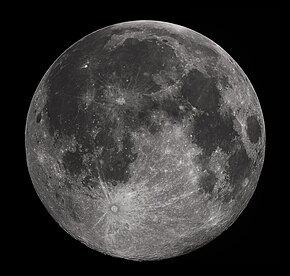 | |||||||||||||
| Designations | |||||||||||||
|---|---|---|---|---|---|---|---|---|---|---|---|---|---|
Designation | Earth I | ||||||||||||
| Adjectives | |||||||||||||
| Symbol | |||||||||||||
| Orbital characteristics | |||||||||||||
| Epoch J2000 | |||||||||||||
| Perigee | 362600 km (356400–370400 km) | ||||||||||||
| Apogee | 405400 km (404000–406700 km) | ||||||||||||
| 384399 km (1.28 ls, 0.00257 AU)[1] | |||||||||||||
| Eccentricity | 0.0549[1] | ||||||||||||
29.530589 d (29 d 12 h 44 min 2.9 s) | |||||||||||||
Average orbital speed | 1.022 km/s | ||||||||||||
| Inclination | 5.145° to the ecliptic[2][a] | ||||||||||||
Regressing by one revolution in 18.61 years | |||||||||||||
Progressing by one revolution in 8.85 years | |||||||||||||
| Satellite of | Earth[b][3] | ||||||||||||
| Physical characteristics | |||||||||||||
Mean radius | 1737.4 km (0.2727 of Earth's)[1][4][5] | ||||||||||||
Equatorial radius | 1738.1 km (0.2725 of Earth's)[4] | ||||||||||||
Polar radius | 1736.0 km (0.2731 of Earth's)[4] | ||||||||||||
| Flattening | 0.0012[4] | ||||||||||||
| Circumference | 10921 km (equatorial) | ||||||||||||
| 3.793×107 km2 (0.074 of Earth's) | |||||||||||||
| Volume | 2.1958×1010 km3 (0.02 of Earth's)[4] | ||||||||||||
| Mass | 7.342×1022 kg (0.0123 of Earth's)[1][4][6] | ||||||||||||
Mean density | 3.344 g/cm3[1][4] 0.606 × Earth | ||||||||||||
| 1.622 m/s2 (5.32 ft/s2)[4] 0.1654 g0 | |||||||||||||
| 0.3929±0.0009[7] | |||||||||||||
| 2.38 km/s (8600 km/h; 5300 mph) | |||||||||||||
| 27.321661 d (spin-orbit locked) | |||||||||||||
Equatorial rotation velocity | 4.627 m/s | ||||||||||||
| |||||||||||||
North pole right ascension |
| ||||||||||||
North pole declination | 65.64°[10] | ||||||||||||
| Albedo | 0.136[11] | ||||||||||||
| |||||||||||||
| Surface absorbed dose rate | 13.2 μGy/h (during lunar daytime)[14] | ||||||||||||
| Surface equivalent dose rate | 57.0 μSv/h (during lunar daytime)[14] | ||||||||||||
| 0.2[15] | |||||||||||||
| 29.3 to 34.1 arcminutes[4][d] | |||||||||||||
| Atmosphere[16] | |||||||||||||
Surface pressure | |||||||||||||
| Composition by volume | |||||||||||||
The Moon is Earth's only natural satellite. It orbits at an average distance of 384,400 km (238,900 mi), about 30 times the diameter of Earth. Over time tidal forces between Earth and the Moon have synchronized the rotation period of the Moon (lunar day) to its orbital period around Earth (lunar month) at 29.5 Earth days, causing the same side of the Moon to always face Earth. The Moon's gravitational pull – and to a lesser extent, the Sun's – are the main drivers of Earth's tides.
In geophysical terms the Moon is a planetary-mass object or satellite planet. Its mass is 1.2% that of the Earth, and its diameter is 3,474 km (2,159 mi), roughly one-quarter of Earth's (about as wide as Australia.[17]) Within the Solar System, it is the largest and most massive satellite in relation to its parent planet, the fifth largest and most massive moon overall, and larger and more massive than all known dwarf planets.[18] Its surface gravity is about one sixth of Earth's, about half of that of Mars, and the second highest among all Solar System moons, after Jupiter's moon Io. The body of the Moon is differentiated and terrestrial, with no significant hydrosphere, atmosphere, or magnetic field. It formed 4.51 billion years ago, not long after Earth's formation, out of the debris from a giant impact between Earth and a hypothesized Mars-sized body called Theia.
The lunar surface is covered in lunar dust and marked by mountains, impact craters, their ejecta, ray-like streaks and, mostly on the near side of the Moon, by dark maria ("seas"), which are plains of cooled magma. These maria were formed when molten lava flowed into ancient impact basins. The Moon is, except when passing through Earth's shadow during a lunar eclipse, always illuminated by the Sun, but from Earth the visible illumination shifts during its orbit, producing the lunar phases.[19] The Moon is the brightest celestial object in Earth's night sky. This is mainly due to its large angular diameter, while the reflectance of the lunar surface is comparable to that of asphalt. The apparent size is nearly the same as that of the Sun, allowing it to cover the Sun completely during a total solar eclipse. From Earth about 59% of the lunar surface is visible over time due to cyclical shifts in perspective (libration), making parts of the far side of the Moon visible.
The Moon has been an important source of inspiration and knowledge for humans, having been crucial to cosmography, mythology, religion, art, time keeping, natural science, and spaceflight. On September 13, 1959, the first human-made object to reach an extraterrestrial body arrived on the Moon, the Soviet Union's Luna 2 impactor. In 1966, the Moon became the first extraterrestrial body where soft landings and orbital insertions were achieved. On July 20, 1969, humans for the first time landed on the Moon and any extraterrestrial body, at Mare Tranquillitatis with the lander Eagle of the United States' Apollo 11 mission. Five more crews were sent between then and 1972, each with two men landing on the surface. The longest stay was 75 hours by the Apollo 17 crew. Since then, exploration of the Moon has continued robotically, and crewed missions are being planned to return beginning in the late 2020s.
Names and etymology
The usual English proper name for Earth's natural satellite is simply Moon, with a capital M.[20][21] The noun moon is derived from Old English mōna, which (like all its Germanic cognates) stems from Proto-Germanic *mēnōn,[22] which in turn comes from Proto-Indo-European *mēnsis "month"[23] (from earlier *mēnōt, genitive *mēneses) which may be related to the verb "measure" (of time).[24]
Occasionally, the name Luna /ˈluːnə/ is used in scientific writing[25] and especially in science fiction to distinguish the Earth's moon from others, while in poetry "Luna" has been used to denote personification of the Moon.[26] Cynthia /ˈsɪnθiə/ is another poetic name, though rare, for the Moon personified as a goddess,[27] while Selene /səˈliːniː/ (literally "Moon") is the Greek goddess of the Moon.
The English adjective pertaining to the Moon is "lunar", derived from the Latin word for the Moon, lūna. Selenian /səliːniən/[28] is an adjective used to describe the Moon as a world, rather than as a celestial object,[29] but its use is rare. It is derived from σελήνη selēnē, the Greek word for the Moon, and its cognate selenic was originally a rare synonym[30] but now nearly always refers to the chemical element selenium.[31] The element name selenium and the prefix seleno- (as in selenography, the study of the physical features of the Moon) come from this Greek word.[32][33]
The Greek goddess of the wilderness and the hunt, Artemis, equated with the Roman Diana, one of whose symbols was the Moon and who was often regarded as the goddess of the Moon, was also called Cynthia, from her legendary birthplace on Mount Cynthus.[34] These names – Luna, Cynthia and Selene – are reflected in technical terms for lunar orbits such as apolune, pericynthion and selenocentric.
The astronomical symbol for the Moon is a crescent, ![]() , for example in M☾ 'lunar mass' (also ML).
, for example in M☾ 'lunar mass' (also ML).
Natural history
Lunar geologic timescale

The lunar geological periods are named after their characteristic features, from most impact craters outside the dark mare, to the mare and later craters, and finally the young, still bright and therefore readily visible craters with ray systems like Copernicus or Tycho.
Formation
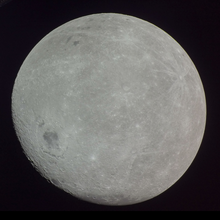
Isotope dating of lunar samples suggests the Moon formed around 50 million years after the origin of the Solar System.[37][38] Historically, several formation mechanisms have been proposed,[39] but none satisfactorily explains the features of the Earth–Moon system. A fission of the Moon from Earth's crust through centrifugal force[40] would require too great an initial rotation rate of Earth.[41] Gravitational capture of a pre-formed Moon[42] depends on an unfeasibly extended atmosphere of Earth to dissipate the energy of the passing Moon.[41] A co-formation of Earth and the Moon together in the primordial accretion disk does not explain the depletion of metals in the Moon.[41] None of these hypotheses can account for the high angular momentum of the Earth–Moon system.[43]
The prevailing theory is that the Earth–Moon system formed after a giant impact of a Mars-sized body (named Theia) with the proto-Earth. The oblique impact blasted material into orbit about the Earth and the material accreted and formed the Moon[44][45] just beyond the Earth's Roche limit of ~2.56 R🜨.[46]
Giant impacts are thought to have been common in the early Solar System. Computer simulations of giant impacts have produced results that are consistent with the mass of the lunar core and the angular momentum of the Earth–Moon system. These simulations show that most of the Moon derived from the impactor, rather than the proto-Earth.[47] However, models from 2007 and later suggest a larger fraction of the Moon derived from the proto-Earth.[48][49][50][51] Other bodies of the inner Solar System such as Mars and Vesta have, according to meteorites from them, very different oxygen and tungsten isotopic compositions compared to Earth. However, Earth and the Moon have nearly identical isotopic compositions. The isotopic equalization of the Earth-Moon system might be explained by the post-impact mixing of the vaporized material that formed the two,[52] although this is debated.[53]
The impact would have released enough energy to liquefy both the ejecta and the Earth's crust, forming a magma ocean. The liquefied ejecta could have then re-accreted into the Earth–Moon system.[54][55] The newly formed Moon would have had its own magma ocean; its depth is estimated from about 500 km (300 miles) to 1,737 km (1,079 miles).[54]
While the giant-impact theory explains many lines of evidence, some questions are still unresolved, most of which involve the Moon's composition.[56] Models that have the Moon acquiring a significant amount of the proto-earth are more difficult to reconcile with geochemical data for the isotopes of zirconium, oxygen, silicon, and other elements.[57] Above a high resolution threshold for simulations,[clarify] a study published in 2022 finds that giant impacts can immediately place a satellite with similar mass and iron content to the Moon into orbit far outside Earth's Roche limit. Even satellites that initially pass within the Roche limit can reliably and predictably survive, by being partially stripped and then torqued onto wider, stable orbits.[58]
On November 1, 2023, scientists reported that, according to computer simulations, remnants of a protoplanet, named Theia, could be inside the Earth, left over from a collision with the Earth in ancient times, and afterwards becoming the Moon.[59][60]
Natural development

The newly formed Moon settled into a much closer Earth orbit than it has today. Each body therefore appeared much larger in the sky of the other, eclipses were more frequent, and tidal effects were stronger.[61] Due to tidal acceleration, the Moon's orbit around Earth has become significantly larger, with a longer period.[62]
Following formation, the Moon has cooled and most of its atmosphere has been stripped.[63] The lunar surface has since been shaped by large impact events and many small ones, forming a landscape featuring craters of all ages.
The Moon was volcanically active until 1.2 billion years ago, which laid down the prominent lunar maria. Most of the mare basalts erupted during the Imbrian period, 3.3–3.7 billion years ago, though some are as young as 1.2 billion years[64] and some as old as 4.2 billion years.[65] There are differing explanations for the eruption of mare basalts, particularly their uneven occurrence which mainly appear on the near-side. Causes of the distribution of the lunar highlands on the far side are also not well understood. Topological measurements show the near side crust is thinner than the far side. One possible scenario then is that large impacts on the near side may have made it easier for lava to flow onto the surface.[66]
Physical characteristics
The Moon is a very slightly scalene ellipsoid due to tidal stretching, with its long axis displaced 30° from facing the Earth, due to gravitational anomalies from impact basins. Its shape is more elongated than current tidal forces can account for. This 'fossil bulge' indicates that the Moon solidified when it orbited at half its current distance to the Earth, and that it is now too cold for its shape to restore hydrostatic equilibrium at its current orbital distance.[67]
Size and mass
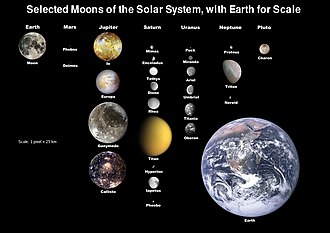
The Moon is by size and mass the fifth largest natural satellite of the Solar System, categorizable as one of its planetary-mass moons, making it a satellite planet under the geophysical definitions of the term.[18] It is smaller than Mercury and considerably larger than the largest dwarf planet of the Solar System, Pluto. While the minor-planet moon Charon of the Pluto-Charon system is larger relative to Pluto,[f][68] the Moon is the largest natural satellite of the Solar System relative to their primary planets.[g]
The Moon's diameter is about 3,500 km, more than a quarter of Earth's, with the face of the Moon comparable to the width of either Australia,[17] Europe or the US without Alaska.[69] The whole surface area of the Moon is about 38 million square kilometers, almost exactly the area of the whole American landmass.
The Moon's mass is 1/81 of Earth's,[70] being the second densest among the planetary moons, and having the second highest surface gravity, after Io, at 0.1654 g and an escape velocity of 2.38 km/s (8600 km/h; 5300 mph).
Structure

The Moon is a differentiated body that was initially in hydrostatic equilibrium but has since departed from this condition.[71] It has a geochemically distinct crust, mantle, and core. The Moon has a solid iron-rich inner core with a radius possibly as small as 240 kilometres (150 mi) and a fluid outer core primarily made of liquid iron with a radius of roughly 300 kilometres (190 mi). Around the core is a partially molten boundary layer with a radius of about 500 kilometres (310 mi).[72][73] This structure is thought to have developed through the fractional crystallization of a global magma ocean shortly after the Moon's formation 4.5 billion years ago.[74]
Crystallization of this magma ocean would have created a mafic mantle from the precipitation and sinking of the minerals olivine, clinopyroxene, and orthopyroxene; after about three-quarters of the magma ocean had crystallized, lower-density plagioclase minerals could form and float into a crust atop.[75] The final liquids to crystallize would have been initially sandwiched between the crust and mantle, with a high abundance of incompatible and heat-producing elements.[1] Consistent with this perspective, geochemical mapping made from orbit suggests a crust of mostly anorthosite.[16] The Moon rock samples of the flood lavas that erupted onto the surface from partial melting in the mantle confirm the mafic mantle composition, which is more iron-rich than that of Earth.[1] The crust is on average about 50 kilometres (31 mi) thick.[1]
The Moon is the second-densest satellite in the Solar System, after Io.[76] However, the inner core of the Moon is small, with a radius of about 350 kilometres (220 mi) or less,[1] around 20% of the radius of the Moon. Its composition is not well understood, but is probably metallic iron alloyed with a small amount of sulfur and nickel; analyzes of the Moon's time-variable rotation suggest that it is at least partly molten.[77] The pressure at the lunar core is estimated to be 5 GPa (49,000 atm).[78]
Gravitational field

On average the Moon's surface gravity is 1.62 m/s2[4] (0.1654 g; 5.318 ft/s2), about half of the surface gravity of Mars and about a sixth of Earth's.
The Moon's gravitational field is not uniform. The details of the gravitational field have been measured through tracking the Doppler shift of radio signals emitted by orbiting spacecraft. The main lunar gravity features are mascons, large positive gravitational anomalies associated with some of the giant impact basins, partly caused by the dense mare basaltic lava flows that fill those basins.[81][82] The anomalies greatly influence the orbit of spacecraft about the Moon. There are some puzzles: lava flows by themselves cannot explain all of the gravitational signature, and some mascons exist that are not linked to mare volcanism.[83]
Magnetic field
The Moon has an external magnetic field of less than 0.2 nanoteslas,[84] or less than one hundred thousandth that of Earth. The Moon does not have a global dipolar magnetic field and only has crustal magnetization likely acquired early in its history when a dynamo was still operating.[85][86] Early in its history, 4 billion years ago, its magnetic field strength was likely close to that of Earth today.[84] This early dynamo field apparently expired by about one billion years ago, after the lunar core had crystallized.[84] Theoretically, some of the remnant magnetization may originate from transient magnetic fields generated during large impacts through the expansion of plasma clouds. These clouds are generated during large impacts in an ambient magnetic field. This is supported by the location of the largest crustal magnetizations situated near the antipodes of the giant impact basins.[87]
Atmosphere

The Moon has an atmosphere so tenuous as to be nearly vacuum, with a total mass of less than 10 tonnes (9.8 long tons; 11 short tons).[92] The surface pressure of this small mass is around 3 × 10−15 atm (0.3 nPa); it varies with the lunar day. Its sources include outgassing and sputtering, a product of the bombardment of lunar soil by solar wind ions.[16][93] Elements that have been detected include sodium and potassium, produced by sputtering (also found in the atmospheres of Mercury and Io); helium-4 and neon[94] from the solar wind; and argon-40, radon-222, and polonium-210, outgassed after their creation by radioactive decay within the crust and mantle.[95][96] The absence of such neutral species (atoms or molecules) as oxygen, nitrogen, carbon, hydrogen and magnesium, which are present in the regolith, is not understood.[95] Water vapor has been detected by Chandrayaan-1 and found to vary with latitude, with a maximum at ~60–70 degrees; it is possibly generated from the sublimation of water ice in the regolith.[97] These gases either return into the regolith because of the Moon's gravity or are lost to space, either through solar radiation pressure or, if they are ionized, by being swept away by the solar wind's magnetic field.[95]
Studies of Moon magma samples retrieved by the Apollo missions demonstrate that the Moon had once possessed a relatively thick atmosphere for a period of 70 million years between 3 and 4 billion years ago. This atmosphere, sourced from gases ejected from lunar volcanic eruptions, was twice the thickness of that of present-day Mars. The ancient lunar atmosphere was eventually stripped away by solar winds and dissipated into space.[63]
A permanent Moon dust cloud exists around the Moon, generated by small particles from comets. Estimates are 5 tons of comet particles strike the Moon's surface every 24 hours, resulting in the ejection of dust particles. The dust stays above the Moon approximately 10 minutes, taking 5 minutes to rise, and 5 minutes to fall. On average, 120 kilograms of dust are present above the Moon, rising up to 100 kilometers above the surface. Dust counts made by LADEE's Lunar Dust EXperiment (LDEX) found particle counts peaked during the Geminid, Quadrantid, Northern Taurid, and Omicron Centaurid meteor showers, when the Earth, and Moon pass through comet debris. The lunar dust cloud is asymmetric, being more dense near the boundary between the Moon's dayside and nightside.[98][99]
Surface conditions

Ionizing radiation from cosmic rays, the Sun and the resulting neutron radiation[101] produce radiation levels on average of 1.369 millisieverts per day during lunar daytime,[14] which is about 2.6 times more than on the International Space Station with 0.53 millisieverts per day at about 400 km above Earth in orbit, 5–10 times more than during a trans-Atlantic flight, 200 times more than on Earth's surface.[102] For further comparison radiation on a flight to Mars is about 1.84 millisieverts per day and on Mars on average 0.64 millisieverts per day, with some locations on Mars possibly having levels as low as 0.342 millisieverts per day.[103][104]
The Moon's axial tilt with respect to the ecliptic is only 1.5427°,[8][105] much less than the 23.44° of Earth. Because of this small tilt, the Moon's solar illumination varies much less with season than on Earth and it allows for the existence of some peaks of eternal light at the Moon's north pole, at the rim of the crater Peary.
The surface is exposed to drastic temperature differences ranging from 140 °C to −171 °C depending on the solar irradiance. Because of the lack of atmosphere, temperatures of different areas vary particularly upon whether they are in sunlight or shadow,[106] making topographical details play a decisive role on local surface temperatures.[107] Parts of many craters, particularly the bottoms of many polar craters,[108] are permanently shadowed, these "craters of eternal darkness" have extremely low temperatures. The Lunar Reconnaissance Orbiter measured the lowest summer temperatures in craters at the southern pole at 35 K (−238 °C; −397 °F)[109] and just 26 K (−247 °C; −413 °F) close to the winter solstice in the north polar crater Hermite. This is the coldest temperature in the Solar System ever measured by a spacecraft, colder even than the surface of Pluto.[107]
Blanketed on top of the Moon's crust is a highly comminuted (broken into ever smaller particles) and impact gardened mostly gray surface layer called regolith, formed by impact processes. The finer regolith, the lunar soil of silicon dioxide glass, has a texture resembling snow and a scent resembling spent gunpowder.[110] The regolith of older surfaces is generally thicker than for younger surfaces: it varies in thickness from 10–15 m (33–49 ft) in the highlands and 4–5 m (13–16 ft) in the maria.[111] Beneath the finely comminuted regolith layer is the megaregolith, a layer of highly fractured bedrock many kilometers thick.[112]
These extreme conditions for example are considered to make it unlikely for spacecraft to harbor bacterial spores at the Moon longer than just one lunar orbit.[113]
Surface features
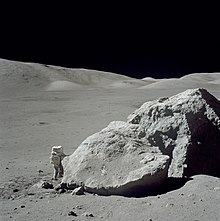
The topography of the Moon has been measured with laser altimetry and stereo image analysis.[114] Its most extensive topographic feature is the giant far-side South Pole–Aitken basin, some 2,240 km (1,390 mi) in diameter, the largest crater on the Moon and the second-largest confirmed impact crater in the Solar System.[115][116] At 13 km (8.1 mi) deep, its floor is the lowest point on the surface of the Moon.[115][117] The highest elevations of the Moon's surface are located directly to the northeast, which might have been thickened by the oblique formation impact of the South Pole–Aitken basin.[118] Other large impact basins such as Imbrium, Serenitatis, Crisium, Smythii, and Orientale possess regionally low elevations and elevated rims.[115] The far side of the lunar surface is on average about 1.9 km (1.2 mi) higher than that of the near side.[1]
The discovery of fault scarp cliffs suggest that the Moon has shrunk by about 90 metres (300 ft) within the past billion years.[119] Similar shrinkage features exist on Mercury. Mare Frigoris, a basin near the north pole long assumed to be geologically dead, has cracked and shifted. Since the Moon does not have tectonic plates, its tectonic activity is slow and cracks develop as it loses heat.[120]
Volcanic features

The main features visible from Earth by the naked eye are dark and relatively featureless lunar plains called maria (singular mare; Latin for "seas", as they were once believed to be filled with water)[121] are vast solidified pools of ancient basaltic lava. Although similar to terrestrial basalts, lunar basalts have more iron and no minerals altered by water.[122] The majority of these lava deposits erupted or flowed into the depressions associated with impact basins. Several geologic provinces containing shield volcanoes and volcanic domes are found within the near side "maria".[123]
Almost all maria are on the near side of the Moon, and cover 31% of the surface of the near side[70] compared with 2% of the far side.[124] This is likely due to a concentration of heat-producing elements under the crust on the near side, which would have caused the underlying mantle to heat up, partially melt, rise to the surface and erupt.[75][125][126] Most of the Moon's mare basalts erupted during the Imbrian period, 3.3–3.7 billion years ago, though some being as young as 1.2 billion years[64] and as old as 4.2 billion years.[65]
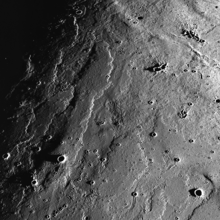
In 2006, a study of Ina, a tiny depression in Lacus Felicitatis, found jagged, relatively dust-free features that, because of the lack of erosion by infalling debris, appeared to be only 2 million years old.[127] Moonquakes and releases of gas indicate continued lunar activity.[127] Evidence of recent lunar volcanism has been identified at 70 irregular mare patches, some less than 50 million years old. This raises the possibility of a much warmer lunar mantle than previously believed, at least on the near side where the deep crust is substantially warmer because of the greater concentration of radioactive elements.[128][129][130][131] Evidence has been found for 2–10 million years old basaltic volcanism within the crater Lowell,[132][133] inside the Orientale basin. Some combination of an initially hotter mantle and local enrichment of heat-producing elements in the mantle could be responsible for prolonged activities on the far side in the Orientale basin.[134][135]
The lighter-colored regions of the Moon are called terrae, or more commonly highlands, because they are higher than most maria. They have been radiometrically dated to having formed 4.4 billion years ago, and may represent plagioclase cumulates of the lunar magma ocean.[65][64] In contrast to Earth, no major lunar mountains are believed to have formed as a result of tectonic events.[136]
The concentration of maria on the near side likely reflects the substantially thicker crust of the highlands of the Far Side, which may have formed in a slow-velocity impact of a second moon of Earth a few tens of millions of years after the Moon's formation.[137][138] Alternatively, it may be a consequence of asymmetrical tidal heating when the Moon was much closer to the Earth.[139]
Impact craters
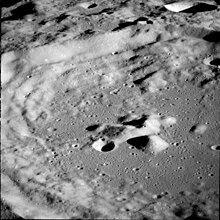
A major geologic process that has affected the Moon's surface is impact cratering,[140] with craters formed when asteroids and comets collide with the lunar surface. There are estimated to be roughly 300,000 craters wider than 1 km (0.6 mi) on the Moon's near side.[141] The lunar geologic timescale is based on the most prominent impact events, including Nectaris, Imbrium, and Orientale; structures characterized by multiple rings of uplifted material, between hundreds and thousands of kilometers in diameter and associated with a broad apron of ejecta deposits that form a regional stratigraphic horizon.[142] The lack of an atmosphere, weather, and recent geological processes mean that many of these craters are well-preserved. Although only a few multi-ring basins have been definitively dated, they are useful for assigning relative ages. Because impact craters accumulate at a nearly constant rate, counting the number of craters per unit area can be used to estimate the age of the surface.[142] The radiometric ages of impact-melted rocks collected during the Apollo missions cluster between 3.8 and 4.1 billion years old: this has been used to propose a Late Heavy Bombardment period of increased impacts.[143]
High-resolution images from the Lunar Reconnaissance Orbiter in the 2010s show a contemporary crater-production rate significantly higher than was previously estimated. A secondary cratering process caused by distal ejecta is thought to churn the top two centimeters of regolith on a timescale of 81,000 years.[144][145] This rate is 100 times faster than the rate computed from models based solely on direct micrometeorite impacts.[146]
Lunar swirls

Lunar swirls are enigmatic features found across the Moon's surface. They are characterized by a high albedo, appear optically immature (i.e. the optical characteristics of a relatively young regolith), and often have a sinuous shape. Their shape is often accentuated by low albedo regions that wind between the bright swirls. They are located in places with enhanced surface magnetic fields and many are located at the antipodal point of major impacts. Well known swirls include the Reiner Gamma feature and Mare Ingenii. They are hypothesized to be areas that have been partially shielded from the solar wind, resulting in slower space weathering.[147]
Presence of water
Liquid water cannot persist on the lunar surface. When exposed to solar radiation, water quickly decomposes through a process known as photodissociation and is lost to space. However, since the 1960s, scientists have hypothesized that water ice may be deposited by impacting comets or possibly produced by the reaction of oxygen-rich lunar rocks, and hydrogen from solar wind, leaving traces of water which could possibly persist in cold, permanently shadowed craters at either pole on the Moon.[148][149] Computer simulations suggest that up to 14,000 km2 (5,400 sq mi) of the surface may be in permanent shadow.[108] The presence of usable quantities of water on the Moon is an important factor in rendering lunar habitation as a cost-effective plan; the alternative of transporting water from Earth would be prohibitively expensive.[150]
In years since, signatures of water have been found to exist on the lunar surface.[151] In 1994, the bistatic radar experiment located on the Clementine spacecraft, indicated the existence of small, frozen pockets of water close to the surface. However, later radar observations by Arecibo, suggest these findings may rather be rocks ejected from young impact craters.[152] In 1998, the neutron spectrometer on the Lunar Prospector spacecraft showed that high concentrations of hydrogen are present in the first meter of depth in the regolith near the polar regions.[153] Volcanic lava beads, brought back to Earth aboard Apollo 15, showed small amounts of water in their interior.[154]

The 2008 Chandrayaan-1 spacecraft has since confirmed the existence of surface water ice, using the on-board Moon Mineralogy Mapper. The spectrometer observed absorption lines common to hydroxyl, in reflected sunlight, providing evidence of large quantities of water ice, on the lunar surface. The spacecraft showed that concentrations may possibly be as high as 1,000 ppm.[155] Using the mapper's reflectance spectra, indirect lighting of areas in shadow confirmed water ice within 20° latitude of both poles in 2018.[156] In 2009, LCROSS sent a 2,300 kg (5,100 lb) impactor into a permanently shadowed polar crater, and detected at least 100 kg (220 lb) of water in a plume of ejected material.[157][158] Another examination of the LCROSS data showed the amount of detected water to be closer to 155 ± 12 kg (342 ± 26 lb).[159]
In May 2011, 615–1410 ppm water in melt inclusions in lunar sample 74220 was reported,[160] the famous high-titanium "orange glass soil" of volcanic origin collected during the Apollo 17 mission in 1972. The inclusions were formed during explosive eruptions on the Moon approximately 3.7 billion years ago. This concentration is comparable with that of magma in Earth's upper mantle. Although of considerable selenological interest, this insight does not mean that water is easily available since the sample originated many kilometers below the surface, and the inclusions are so difficult to access that it took 39 years to find them with a state-of-the-art ion microprobe instrument.
Analysis of the findings of the Moon Mineralogy Mapper (M3) revealed in August 2018 for the first time "definitive evidence" for water-ice on the lunar surface.[161][162] The data revealed the distinct reflective signatures of water-ice, as opposed to dust and other reflective substances.[163] The ice deposits were found on the North and South poles, although it is more abundant in the South, where water is trapped in permanently shadowed craters and crevices, allowing it to persist as ice on the surface since they are shielded from the sun.[161][163]
In October 2020, astronomers reported detecting molecular water on the sunlit surface of the Moon by several independent spacecraft, including the Stratospheric Observatory for Infrared Astronomy (SOFIA).[164][165][166][167]
Earth–Moon system
Orbit
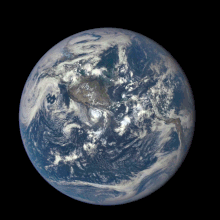
The Earth and the Moon form the Earth-Moon satellite system with a shared center of mass, or barycenter. This barycenter is 1,700 km (1,100 mi) (about a quarter of Earth's radius) beneath the Earth's surface.
Zdroj:https://en.wikipedia.org?pojem=Earth–Moon_system
Text je dostupný za podmienok Creative Commons Attribution/Share-Alike License 3.0 Unported; prípadne za ďalších podmienok. Podrobnejšie informácie nájdete na stránke Podmienky použitia.
Antropológia
Aplikované vedy
Bibliometria
Dejiny vedy
Encyklopédie
Filozofia vedy
Forenzné vedy
Humanitné vedy
Knižničná veda
Kryogenika
Kryptológia
Kulturológia
Literárna veda
Medzidisciplinárne oblasti
Metódy kvantitatívnej analýzy
Metavedy
Metodika
Text je dostupný za podmienok Creative
Commons Attribution/Share-Alike License 3.0 Unported; prípadne za ďalších
podmienok.
Podrobnejšie informácie nájdete na stránke Podmienky
použitia.
www.astronomia.sk | www.biologia.sk | www.botanika.sk | www.dejiny.sk | www.economy.sk | www.elektrotechnika.sk | www.estetika.sk | www.farmakologia.sk | www.filozofia.sk | Fyzika | www.futurologia.sk | www.genetika.sk | www.chemia.sk | www.lingvistika.sk | www.politologia.sk | www.psychologia.sk | www.sexuologia.sk | www.sociologia.sk | www.veda.sk I www.zoologia.sk
